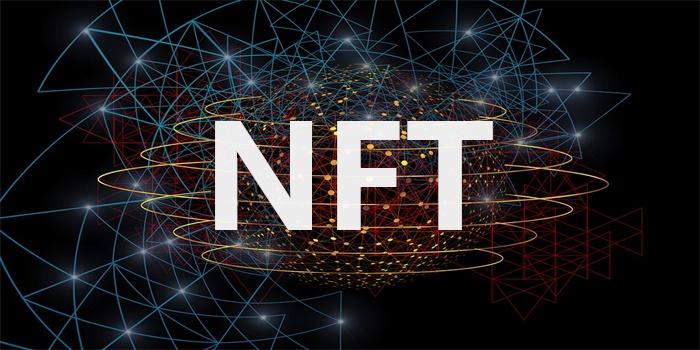How to discover a good NFT?
Author: NFT Labs
NFTs involve various categories such as art, gaming, and more, and whether to purchase an NFT is often closely related to personal preferences and tastes. However, as a type of digital asset, the asset characteristics determine that there are multiple ways to subjectively or objectively evaluate and appraise them. In addition to purely subjective perspectives, there are some methods that can help us assess the value of an NFT and determine its potential as a collectible.
Traditional Valuation Methods
Currently, according to valuation theory, there are mainly three valuation methods: the income approach, the asset approach, and the market approach. All three methods can serve as a basis for determining the subject matter and measuring fair market value.
Income Approach
In terms of the income approach, to value NFTs, investors need to assess their profitability (i.e., economic benefits or cash flow). This cash flow can be empowered for creators through payments such as secondary creations and royalties. In this case, investors can estimate the appropriate additional costs associated with NFTs in circulation.
The method of using royalty exemptions can be used to derive the fair market value of the subject NFT, which is an income-based approach where the value is based on the cost savings from not having to pay royalties due to owning the NFT subject asset. For example, if an artist creates an NFT music album, investors can estimate the revenue stream associated with the subject asset and apply an appropriate royalty rate to calculate the savings on royalties.
For instance, on Ethereum.org, the original owner of EulerBeats receives an 8% royalty every time the NFT is sold. Once the royalty balance is calculated, it can be adjusted to a post-tax basis and discounted to present value. The discount rate should take into account the inherent risks associated with this type of asset, and the sum of the present value of post-tax royalty savings will represent the fair market value of the subject NFT.
Asset Approach
Regarding the asset approach, we can view NFTs or the ownership of NFTs as a non-operating portfolio of asset holdings. The fair market value of a single NFT asset can be approximated based on comparable NFT asset categories currently available in several NFT markets. Additionally, if a specific project's unique digital asset is used to purchase the NFT, the value of the NFTs is likely determined by the value of the digital asset used in the transaction, with the data involved in the transaction better reflecting fair market value.
Market Approach
Finally, applying the market approach, generally speaking, the popularity of NFTs is driven by marketing, and most hot NFTs are backed by corresponding companies. When using the market approach, investors can choose comparable companies whose primary business is NFTs or companies that invest in NFTs and determine appropriate valuation multiples applicable to the subject being assessed. The selected multiples may include, for example, enterprise value to revenue ratio, enterprise value to EBITDA ratio, and so on.
By studying the companies behind NFTs, one can analyze the trading multiples of NFTs, such as sale price, the ratio of sale price to seller's disposable income, or the ratio of sale price to EBITDA, which can be determined and applied to the financial characteristics of the subject entity.
Lastly, it should be noted that a company may own one or more types of NFTs as investments or non-operating assets, and may also have other businesses.
Five Key Questions
1. Are the NFTs on-chain and are they mutable?
Nowadays, most NFTs are minted on-chain, relying on their respective Ethereum smart contracts for existence, which means NFTs can exist for a long time. On the other hand, some NFT projects mint NFTs by relying on external off-chain providers like AWS, which, while convenient and flexible to some extent, also creates trust issues. Therefore, users must trust that the project can sustain itself and keep its servers running. Otherwise, the effective lifespan of the NFT may only be a few years.
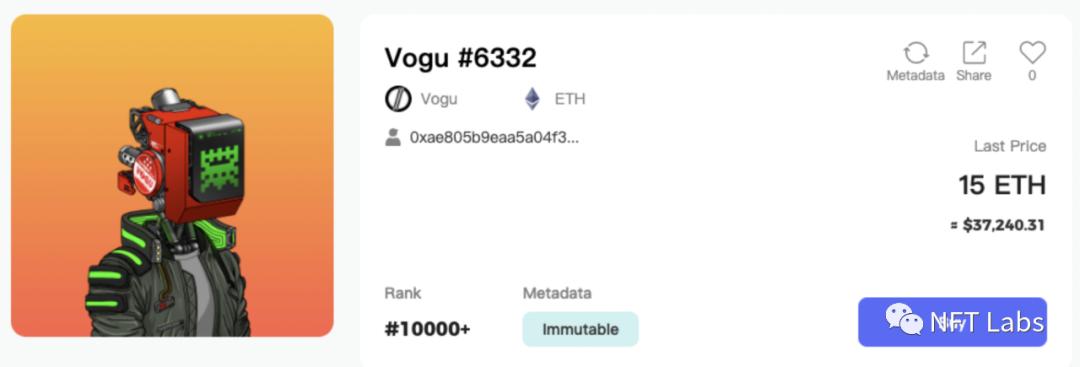
Data Source: NFTGO
2. Are the NFTs issued in unlimited quantities, or do they have scarcity; what is the relative and absolute scarcity?
In the NFT ecosystem, we see that creators release NFTs in both unique and multiple quantities (e.g., 10, 50, 100, etc.). Clearly, unique NFTs are very scarce, making them more valuable than multiple quantity works. However, this does not mean that multiple quantity versions of NFTs have no value; we often see some multiple quantity NFTs priced at thousands of dollars, and we need to pay attention to the rarity of NFTs within a Collection.
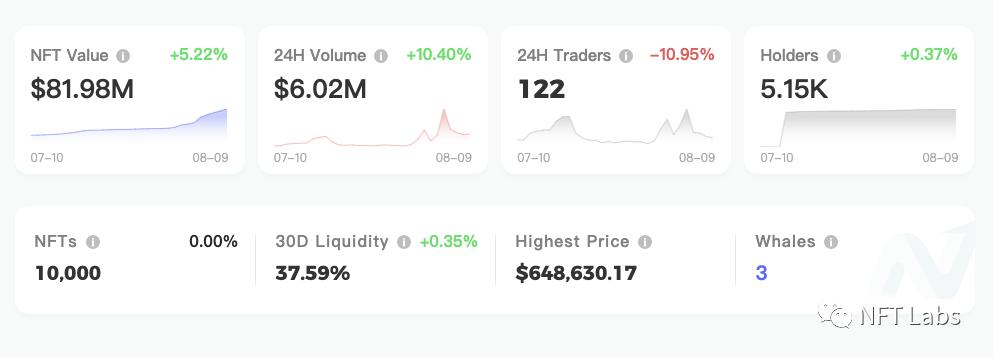
BAYC issued 10,000 NFTs, each unique.
Data Source: NFTGO
Similarly, the number of NFTs released by a creator within a year is also worth noting; is it tens of thousands or just a few? Understanding the production speed of a specific NFT is key to understanding its value. A project that mints unlimited NFTs at a price of 0.01 typically has less appeal than something created by an artist who only makes 25 NFTs.
Of course, outstanding artists who only release a few selected works each year often have their pieces priced higher than those of similarly ranked artists who release works several times a week, and their works are often sold out before they hit the market.
3. When was the NFT minted?
NFTs can also be valued based on their minting time; NFTs began to gain traction at the end of 2020, so NFTs minted before this period hold a certain status as "digital artifacts"—the earliest works in this digital cultural revolution. However, the development of NFTs is still in its early stages, so the factor of "minting time" has not yet played a significant role.
Ultimately, any NFT or anything established before 2030 may hold special significance. At the same time, the earliest NFT projects have already achieved impressive valuations (e.g., CryptoPunks), and this fact has attracted the attention of many collectors.
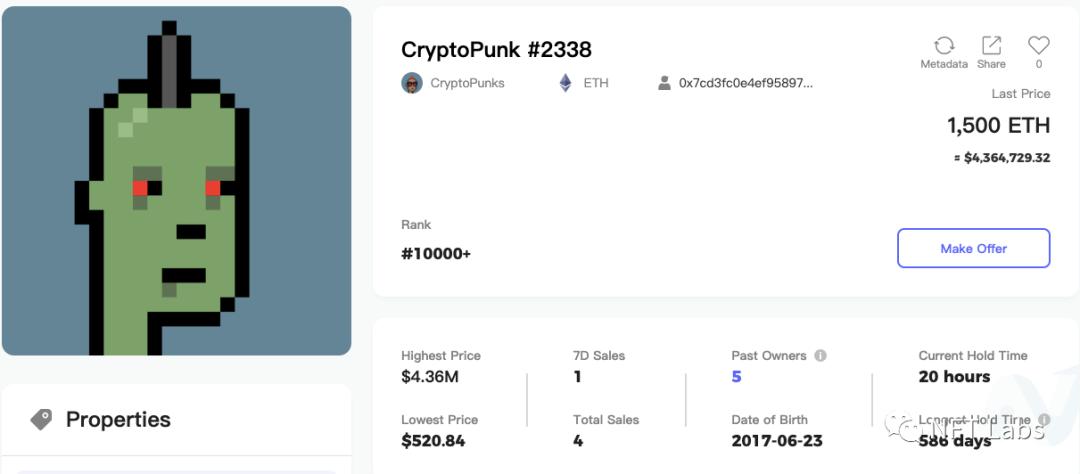
Data Source: NFTGO
4. Does this type of NFT have aesthetic value, or does it have a strong community?
We are starting to see more visual NFT works accompanied by audio, providing users with a richer artistic experience than ordinary NFTs. Who wouldn't enjoy listening to music while playing their NFT? With this in mind, audio can enhance the sensory added value of NFTs, especially when the audio is created in collaboration with the main artist, and we expect to see audiovisual integration become an artistic norm through NFTs.
If someone without fans and no NFT creation history lists an NFT on OpenSea without any promotion, will that piece sell? Without further effort, it certainly won't sell.
This is why NFTs minted by major artists or creators hold value. It is important to involve the community to create demand. Naturally, the more popular the creator and the larger the community, the more valuable the NFT, and this dynamic generally applies to any market.
5. What are the recent interests of the whales? What is their historical record?
From a subjective perspective, aside from being buyers with personal hobbies and preferences in the art world, we can track influential figures. Investing too early in an NFT collection may not yield returns, but by tracking influential sellers, we can observe their personal selling behaviors over time to track the sales trends of an NFT product.
We can also track those "whales" to observe how influential buyers earn profits by buying and selling NFT assets.
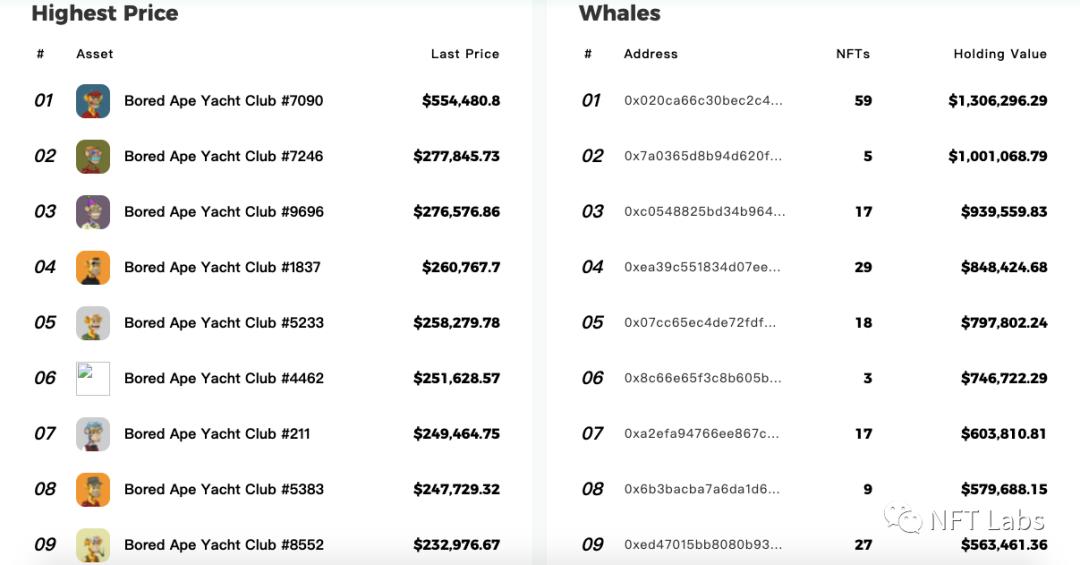
Data Source: NFTGO
Looking at the credibility of trading platforms, many influential NFTs happen to be sold from the same major platform. The credibility of the platform can provide access to higher-quality NFTs. By reviewing the sales history of an NFT, when we see the sale price continuously rising, we can infer that it has good momentum, and it may be a good time to buy.
When evaluating NFTs, there are not necessarily right or wrong answers, but if we attempt to do valuations, we will inevitably consider many dynamic factors. The best approach is to take a holistic view to understand all aspects of a piece before making a decision.
In the past, how much was this NFT worth? How much is it worth today, and how much will it be worth in the future? How has its value changed over time—has it changed rapidly or suddenly, will it grow or fall into a trough? Delving into these questions can help better assess NFTs.
How to Quickly Master First-Hand Information?
NFTs are primarily minted on various chains such as Ethereum, Flow, and BSC, and each blockchain has an isolated protocol ecosystem. While these individual protocols offer diverse NFT experiences, decentralized trading markets face significant challenges when trading and viewing NFT information or spreading across multiple protocols.
On one hand, users who are new to NFTs may not know which exchanges can be used to purchase NFTs; on the other hand, different exchanges have different trading interfaces, which increases users' cognitive and learning costs to some extent.
Imagine you want to find the hottest NFT projects or your favorite crypto art in the trading market, only to discover that NFTs from a BSC chain cannot be found in Ethereum's trading market, or even within the same chain, you need to switch between different trading markets to see all NFTs.
If you are an investor, you may want to see all current data and various metrics from all NFT markets, but due to the excessive decentralization of information across chains, data that could originally be viewed in "seconds" now takes tens of minutes to compile.
In this endless world of NFTs, the blockchain carries a vast amount of information. For most newcomers to NFTs, time often feels insufficient, and they spend a lot of time searching for content but still cannot find enough useful information.
Data aggregation refers to summarizing all relevant information and data from across the web and placing all data in one location for user access. On one hand, the data presentation function makes the data aggregator like a giant search engine that only collects necessary information, eliminating all unnecessary information; on the other hand, the data analysis function allows data aggregation to generate various metrics and valuable information from massive data through algorithms and influencing factors for user reference.
An NFT aggregator consolidates various NFT trading information from major chains into one place, saving time and improving efficiency, thus achieving a better trading experience. Aggregators have a wealth of NFT information and also provide rich data dimensions. Users only need one platform to understand current NFT data or market trends, and they can even access and purchase projects directly through it.
Additionally, instead of searching for NFTs on Google or Baidu, users will find searching directly in the aggregator to be more precise and efficient. Currently, some good aggregation platforms include CMC's NFT section, NFTGO, Token Terminal, nonfungible, etc. In the future, NFT Labs will also write a comparative analysis of different data platforms to help everyone choose the platform that suits them.
In summary, different people will use different methods to evaluate NFTs. In addition to the basic information and objective descriptions of NFTs, when searching for valuable NFTs, we must also consider all data and information surrounding them to form our own overview. With such an evaluation process, we can discover valuable NFT products and stay at the forefront of NFT ecosystem research.




